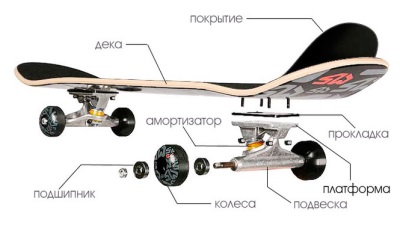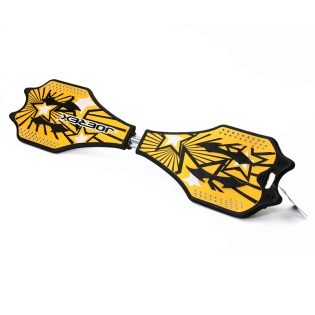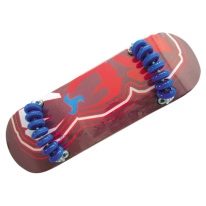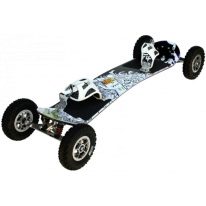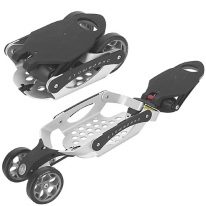How to choose a skateboard for a child and how to learn to skate?
Probably, all parents sooner or later hear from their child a request to buy a skate. And immediately many questions arise: what is it, how many years can one learn to master it, which skate is better to choose a 5-year-old child or a child of 10 - 11 years old? Our article will help answer these and other frequently asked questions.
Design
A classic skateboard is a board (deck), covered with several layers of veneer and mounted on wheels. In some modern models (for example, in cruisers or longboards) the deck is made of plastic.
Skateboard can be used as a vehicle or sports equipment to perform tricks.
The design of a skateboard consists of several basic elements:
- Deca. This is the very board of the skateboard. Consists of several layers of glued maple veneer. As a rule, it is 7 or 9 layers, but for lightweight models 5 layers are used. For children's skateboards, 6-7 layers of veneer are enough.
- Griptape - top deck cover. In appearance it is very similar to sandpaper. Thanks to this self-adhesive tape, the legs do not slide off the skateboard while moving or performing tricks.
- Suspension. Sturdy metal construction for connecting wheels to the board. Most often it is made from an alloy of aluminum with other metals.
- Wheels. The main criterion for selecting wheels is stiffness. Sufficient rigidity makes skate movements smoother. If there is a special area for skating, the wheels can be soft. For a normal yard or street, it is best to choose a board with hard wheels.
- Bearings, pads, base, shock absorbers and other parts.
Types and types
Depending on the size and design, skateboards are divided into several types:
- Longboard - long board. It is characterized by larger and softer wheels. The front part of the skate has a pointed appearance, the rear part is raised.
- Cruiser - board with 4 wheels, which is optimal for driving around the city and smooth roads. Wheels are usually soft or medium hard. It has a raised "tail" at the deck. This is the best option for learning to ride children from 5 years.
- Streetboard, snakeboard. It consists of several platforms. Used to perform stunt items.
- Freeboard. This board has 6 wheels. Used for freestyle.
- Flowboard. Board with 14 wheels, characterized by high maneuverability, ideal for stunt elements.
- Mountainboard. The board is designed to ride over rough terrain. Has wheels with a diameter of about 20 cm.
- Stubord. Folding skateboard. Its main part is not a board, but a metal stand - a foot basket.
From what age is it worth starting skating?
Today, you can see a huge variety of skateboards of a wide variety of designs, sizes and designs. The smallest and lightest models are designed for children 5-6 years.
In general, it is believed that you should not engage in a skateboard for children younger than 7 - 8 years. Of course, you can put on a skate and a 4-5 year old baby, but experts are unanimous: young children do not have good stability and coordination of movements. Therefore, an early acquaintance with a skateboard can result in injuries.
At any age it is necessary to start classes under the supervision of a more experienced and adult trainer. Children from 4 to 5 years old when riding should be held by one hand and insured against falling.
Please note that the body of the child should be tilted forward, so parents should always walk in front of the skate.
Which is better to choose for small children?
How to choose a skate size according to age?
The basic rule for choosing a suitable skate is to match it with the age and height of the young athlete.
The length of the standard board is from 78 to 83 cm, and the width is from 19 to 21.5 cm. However, these dimensions are designed for adults. Therefore, depending on the age of children, there are different sizes of skateboards (we are talking about the traditional skateboard, and not the cruiser):
- Skateboards for children whose height has not yet reached 1 meter. The dimensions of the skate are 27.2 - 27.6 x 6.5 - 6.75 inches (length - about 70 cm).
- Children 6 - 8 years old up to 1.4 m. Board size - 28 x 7 inches. (length - up to 71 cm.)
- Children from 9 to 12 years old are up to 1.5 m. Board size is 29 x 7.3 inches (length is up to 74 cm.).
- Children over 13 years old. Adult skate sizes are suitable.
Manufacturers Review
Of the most famous and popular manufacturers of skateboards include:
- Alien workshop. These are classic, durable boards with large bends. Designed for skiing, not suitable for jumping elements.
- Black Label. One of the most convenient models for beginners skateboarders. They have a stable, strong middle part of the board, but the front and rear parts, due to the deep concave, may eventually begin to break.
- Blind. Boards that differ primarily in their aesthetically appealing appearance. Possess low weight.
- Santa Cruz. Comfortable, sturdy boards of original design. Have a small bend.
- Penny board. High quality Australian brand, which pays great attention to detail. This option is the most popular for buying young children.
For information on how not to fall for scammers and not buy a fake, see the following video on the example of the Penny Board skate:
Tips for choosing
When choosing a suitable skateboard for your child should pay attention to the following points:
- The width of the deck. Can range from 4.7 to 10.62 inches. The narrower the board, the more maneuverable it is, the wider - the more stable. Novice athletes should select models with a small width. In the process of learning, you can choose the optimally suitable model in width.
- The length of the deck. In principle, the length does not affect the speed and quality of riding. The standard size is 31 inches (78.7 cm), but for very young athletes the length of the board may be shorter.
- It is best to buy a skateboard, not made of plastic, but of maple veneer.. Plastic models are much cheaper, but less resilient and durable compared to wooden ones.
- Concave Novice skateboarders are best to buy flat boards, it makes no sense to choose a skateboard with a deep concave (bend). These boards are suitable for more experienced athletes.
- The surface of the board should be smooth and free from cracks, chips or dents.. The tree can deform over time, so it is best to buy a skateboard made recently.
What to consider when choosing for beginner children?
When choosing a skate for a beginner athlete, you should not chase the external beauty and original design.
The skateboard should have the simplest and most convenient form, the size corresponding to the age and height of the child, be made of quality materials.
Skate can be assembled by yourself, purchasing the necessary parts separately, but A beginner child is best to buy a finished board. Preference should be given to brands of well-known, trusted manufacturers. They will be more expensive than plastic analogs, but there will be a firm confidence in their quality, reliability and safety for the child.
How to learn to ride?
Skateboarding is a type of extreme sport. It consists in performing tricks of different degrees of complexity with the help of a skateboard. There are many styles of riding.
The most popular among them are:
- Flatland Skating and performing tricks on a flat surface.
- Straight. Riding on the street with the use of various ladders, railings, ceilings, etc.
- Freestyle. Style, which is characterized by performing tricks and jumps in the same plane.
- Werth. Style with the performance of stunt elements on the ramp.
- A park. Performance of particularly complex and spectacular elements on the ramp.
The first thing to start learning is pick jog. Once mastered the correct formulation, you can learn to push off, move and stop. Do not rush, the process should take some time.
To learn how to learn the basic elements of skateboarding, see the video of the school "In Motion":
What tricks can you do?
The stunt part of skateboarding is, as a rule, the most experienced skateboarders. However, there are quite simple tricks that even a beginner athlete can easily master.
- Ollie (jump with skate). One leg is placed on the rear bend of the board (tail), and the second is in the middle or slightly further. Then, with the foot on the tail, make a click on the ground, and stretch the other foot along the board, as if pulling it out. The legs should be slightly bent. The jump, of course, will not work the first time. In skateboarding, the main thing is constant training. See the next video for details.
- Nolly. It resembles an ollie with the only difference that the movement begins with the foot, which stands in front. She performs a click, and the second leg pulls the skateboard up.
- Manual. Very simple item. Its essence is as follows: the athlete, clicking on the tail, lifts the front of the skateboard and tries to stay on weight, balancing and helping himself with his hands.
You can learn this element faster by watching the following video.
- Ollie with a turn. It is similar to the ollie element, only during its execution it is necessary to try to roll in place with the board. The element begins exactly the same way as the ollie, only after clicking on the ground, with the second leg it is necessary to twist the skate, turning in the same direction and most. You can help with your hands.
Visually familiarize yourself with how to perform the trick of Ollie with a turn, you can in the next video.
- Kickflip. The most complex of the elements presented. It is based on the same ollie, only during its execution it is necessary to try to spin the skate horizontally. Exercise is performed in motion. First, you need to do an ollie exercise, and when the front leg reaches the bend of the board, you have to twist it sharply. After rotation, the board stops with two feet.
Watch the following video before doing this item.
An example of riding a 12-year-old boy (who can be called a professional) on a skateboard can be seen in the next video.
Ultimate safety and protection
Any skateboarder, regardless of his level of training, needs protection, because skateboarding is quite a traumatic sport.
For training it is best to choose free clothes from natural fabrics and comfortable shoes. It is imperative to use means to protect parts of the body that are most susceptible to shocks and injuries: helmet, protection for elbows, knees, wrists, and shins.
It is best to start training on the grounds specially equipped for this - smooth, smooth and without slant. Before training, try to stand on a skateboard on the grass.


